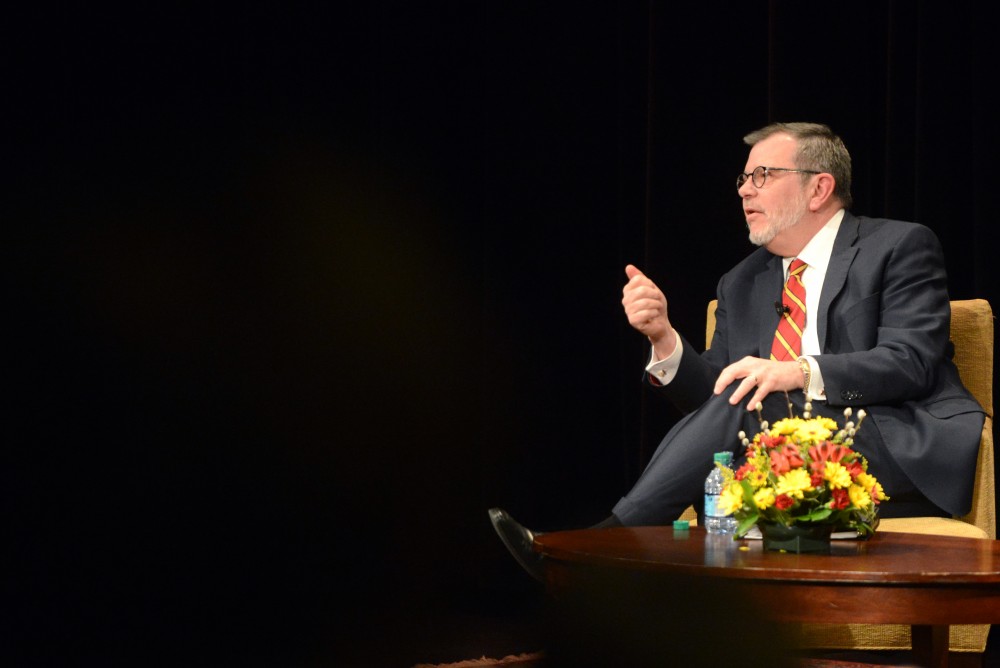As the University enters its fourth year in a plan to trim $90 million in administrative costs by 2019, school officials say the last round of cuts will be the hardest.
Starting in fiscal year 2014, University President Eric Kaler — who pledged to reduce administrative costs in his 2011 inaugural speech — implemented a six-year plan called Operational Excellence, nicknamed “OpEx” by administrators, to cut $90 million from the University’s operating budget across all campuses.
To date, $68.5 million in administrative cuts have been made or are currently being made. Now, the remaining budget reductions could be the hardest to make.
While administrators say the trimmed costs will make the school more efficient, some University offices have been strained due to reduced staff. About 71 percent of cuts so far were personnel, according to the University’s Office of Budget and Finance.
“These cuts hurt,” said University President Eric Kaler. “These were not reductions in services or work streams of people that had nothing to do.”
Julie Tonnesen, associate vice president of the University’s office of budget and finance, said every college and University office has a reallocation target during the school’s annual budget process. Those targets would ideally be reached, she said, but University finance directors said it’s getting harder to do so.
“This has been going on for a few years, and a lot of the low-hanging fruit is gone, and so it’s getting much more difficult for colleges to hit those numbers,” said David Pappone, finance director for the College of Science and Engineering.
Most savings so far have come from eliminating positions or hiring less-experienced employees at lower salaries when spots open, Tonnesen said.
For many office workers and even faculty members, fewer employees means more work.
“We have heard even faculty having to do more work than they did before because their support structure has been impacted,” Tonnesen said. “They have fewer support people. That means things take more time and people have to do things they didn’t have to do before.”
With a target reallocation of $21.5 million in the next two years, Tonnesen said more layoffs could be in store across the University system.
“Depending on who their constituency is … the impact will be different,” Tonnesen said. “I think that’s what we’re going to see more of, which makes those decisions more difficult.”
But, she said administrators try to limit layoffs as much as they can by considering non-personnel costs as well.
Those expenditures might include energy use, travel expenses and purchasing deals with vendors. This could even mean a need to cut some programs.
Pappone said the OpEx process is about balancing efficiency with the desire to keep important programs and services.
He said the high demand for CSE programs in recent years has let them grow revenues and offset their “fair share” of cuts.
“There might be some other colleges where you would find more cutting because they’ve had less revenue,” he said. “But in CSE we’ve still done cutting.”
In 2016, CSE trimmed $400,000 in job positions.
Additionally, Pappone said restructuring in the University’s Office of Information Technology has led to the elimination of IT personnel at CSE. There is now a consolidated IT department for all University schools.
“At each of those stages of consolidation, the expectation is that there will be efficiencies gained,” Pappone said.
Patti Frasher, finance director for the College of Continuing Education, said CCE has also felt the effects of Op Ex.
“We’ve become pretty lean,” she said. “We’re handling it, but it hasn’t necessarily been easy.”
Over $340,000 was cut from CCE in 2016 alone with the elimination of five positions and replacing staff at lower salaries.
She said despite the cuts, the college has kept a focus on advising and student services, but “things are definitely getting a lot harder.”
Regent Richard Beeson, chair of the board’s Finance Committee, said these stresses show that the plan is working.
“I’m okay with that,” he said. “That means they’ll need to get even more creative with where they see reductions.”
Kaler said the school has been under constant pressure from the state to cut costs.
“It certainly causes stress in the organization,” he said. “But at the same time we have a pretty strong mandate from the legislature to become more efficient and that’s what we’re trying to do.”
But Beeson said legislators’ claims of wasteful administrative spending are misguided.
“My own view is that administrative bloat is an urban myth as it relates to the University,” he said. “Having said that, there’s just a continual need and opportunity to look at those expenses.”
The difficulty in weighing the impact of the cuts and communicating their significance to the legislature is that the University has few other schools to adequately compare its expenses to, Beeson said.
Beeson said regents and administrators are already exploring areas to trim costs outside of OpEx, like certain education programming, services and further office consolidation.
“I think we need to step it up and do more,” said Regent Michael Hsu, who sits on the board’s finance committee. “We need to look elsewhere in the organization.”
Hsu said the administration should pay close attention to where the money gets reallocated on top of tracking the cuts.
“That’s what’s missing right now,” he said. “We’ve taken the money away, we don’t know where it went, and we also have some that came back in. I think we need to do more work.”
Kaler said he hopes the plan might soothe the school’s relationship with legislators.
“We’re doing this because as a matter of principle, we should be effective and efficient in what we do,” he said. “But we’re certainly responding to conversations with legislators, and hopefully they see what we’re doing and approve of it.”
















